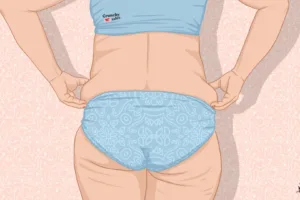How To Deal With Menopause Rage: 4 Steps To Tame Your Temper
Are you finding yourself feeling irritable, frustrated, or even angry lately? If you’re a woman going through menopause, you may be experiencing what is commonly known as “menopause rage.” In this in-depth investigation, Psychologist, Registered Dietitian, Board Certified Health and Wellness Coach Dr Ellen Alberston will provide useful insights on how to manage menopause rage and explore proven methods for regaining control over your emotions and embracing the fullness of life.
Transitioning through menopause can feel like you’re riding an emotional roller coaster. You’re sad and anxious one moment, irritable, confused and angry the next. You may even experience intense rage, exploding at your partner because he looked at you sideways, left his dirty dishes in the sink, or forgot to buy milk at the store.
No, you’re not losing your mind or marriage. Feeling bitchy and experiencing rage are common. According to a study published in the Journal of Psychiatry and Neuroscience, “Irritability is the primary mood complaint for up to 70 per cent of women during the perimenopause.”
Fortunately, there are steps you can take to feel calmer, more in control, and better able to cope with fiery mood swings and a menopausal brain. But first, you have to accept your feelings rather than fight them. After that, you can make changes to improve your self-care, express yourself, and get your needs met.
What Causes Menopause Rage
According to gynaecologist Dr Alyssa Dweck “Menopause rage’ isn’t a formal medical diagnosis, however, women can have significant mood swings related to the hormone variability during perimenopause and the significant decline in hormones during menopause. More severe mood swings may be the result of longer-term persistence of physical symptoms, such as hot flashes, night sweats, and/or disrupted quality or quantity of sleep and further compounded by common midlife stressors.”
Research shows that having a history of severe premenstrual syndrome (PMS), postnatal depression, or clinical depression put you at a greater risk for menopausal mood swings. However, unlike depression, if your moodiness is hormone-related, you’ll probably feel more irritability and anger rather than intense sadness.
As Dr Christiane Northrup says in her book ‘The Wisdom of Menopause‘, “The brain catches fire at menopause. Like the rising heat in our bodies, our brains also become fired up!”.
Basically, she explains that the normal hormonal shifts associated with perimenopause can create changes in the temporal lobe and limbic areas of the brain which can make you feel more irritable, anxious, and emotionally volatile. Fluctuating, relative levels of estrogen, progesterone, and testosterone create the perfect storm for rage.
That’s because they all influence mood. Estrogen impacts the production of the mood stabilizer serotonin. Progesterone is a calming hormone that also supports sleep and relaxation. So, lower levels combined with poor sleep can make you feel irritable. Testosterone is believed to impact mood, serotonin levels, and sleep.
When these hormones decline and/or become unbalanced you can feel more irritable and impatient. As a result common midlife stressors and problems in your life – like an unfulfilling career, caregiver burnout, empty nest, financial pressures, or an unhappy marriage – that you once ignored can trigger rage.
As Clinical and Counseling Psychologists Drs. Avery Hoenig, Jamie Wilson, and Lucy Smith from The Badass Rebellion (a community to help women navigate their midlife years) explain: “While there are certainly hormonal changes that can cause emotional fluctuations during the menopause transition, midlife is also a time of awakening to all of the injustices, imbalances, and unpaid emotional labour you’ve had to navigate for forty-something plus years. The typical emotional reaction to all of this can be irritation, anger, and rage”, they said. “Of course, it can feel uncomfortable, especially if, as a woman, you are used to suppressing anger and discomfort to please others or keep the peace. However, anger and rage point the way for things to be different -what we can or need to change, what we want, or what we don’t want. These feelings motivate us to rebel against the way things have always been and motivate us to work for change.”
Strategies to cope with menopause rage
When it’s time to face menopause symptoms, including your rage, no one-size-fits-all solution exists, so it’s important to explore different approaches and find what works best for you. By implementing these strategies and seeking support from loved ones, you can reclaim your emotional well-being and live your best life during menopause.
Here are four steps you can take to tame the rage by taking care of yourself.
Step 1: Practice Self-compassion
Opening your personal Pandora’s box of emotions and acknowledging how much needs to change can trigger overwhelm and stress. This can put you into fight-or-flight which will ignite rather than tame the rage. So, start to ease your fiery emotions by being easy with yourself.
Practice self-compassion, essentially treating yourself like a good friend. Giving yourself the care, love, and understanding that you want, but may not be receiving from others in and of itself will help tame the rage. Plus, self-compassion is an emotional regulatory technique that anyone can learn.
According to researcher Kristin Neff self-compassion has three elements: Kindness, Common Humanity, and Mindfulness. If you blow up at family or friends, be kind to yourself, rather than judgmental. This will reduce feelings of guilt and regret. You can then learn from your mistakes, forgive yourself, and figure out how to address behaviours that you’d like to change.
Remember, we are all imperfect beings and make mistakes. You’re not alone. Many other women struggle with menopausal rage. When you realize this you move from isolation to connection.
So, next time you start to feel irritable or stressed, practice mindfulness by asking yourself: “What do I need right now?” Then give yourself what you need.
Step 2: Reframe and work wisely with anger
While anger may feel uncomfortable and foreign, especially if you’ve repressed it for years, it isn’t “bad,” “wrong,” or “negative”. Anger is normal and can serve a positive function by making you aware of what’s not working in your life. For example, anger can signal that someone has overstepped a boundary or hurt you. It also provides the energy you need to express or protect yourself, so you aren’t harmed again.
Expressing anger properly can support your well-being. Conversely, suppressing your anger and maintaining the status quo can trigger migraines, resentment, erode relationships, hurt thinking and undermine your health.
What’s key is listening to and working wisely with your anger, so it doesn’t become rage. As Kate Codrington, author of ‘Second Spring‘ explains, “Feeling rage is a natural and valid part of the healing that perimenopause offers: the veil has lifted, and we see the truth of how we have been marginalized. No wonder we’re angry. To deal with the rage we must expand our capacity for feeling it in our bodies. We need to get curious and explore its texture, what it sounds like and how it wants to move and be expressed.”
Start by validating your anger. Telling yourself it’s okay to feel this way. You may even want to find a supportive community of midlife women who share your feelings. Then set an intention to work with your body, mind, and emotions to help tame the rage.
Notice how your mind and body feel when you’re angry. Common physical signs include a churning stomach, a tightness in your chest, or an increase in your heart rate. Anger can also show up as lower back pain because the chronic stress of unexpressed anger can activate the sympathetic, fight-or-flight nervous system putting pressure on the spinal column.
Mentally anger triggers the release of norepinephrine, a neurotransmitter that activates the fight-or-flight response. This can make you feel edgy like you want to lash out at someone. Once you know what anger feels like you can prevent an anger explosion by hitting pause, taking a time-out, and giving yourself what you need to come back into balance. Rather than fighting choose to step away from the situation to regain your composure.
Another strategy is to identify the soft feelings and unmet needs behind the hard feelings of anger. For example, you may long to be loved, feel lonely or want connection or respect. Once you understand your soft emotions and unmet needs use a technique such as Nonviolent Communication to express yourself appropriately so you feel seen and understood. Being honest with loved ones and sharing what you’re going through, rather than bottling up your emotions, is one of the best ways to tame rage.
In addition, track your anger triggers. What lifestyle choices tend to exasperate it? Low blood sugar? Poor sleep? Too much stress, caffeine, or alcohol? Not enough me time? Keep a journal or use a mood-tracking app to identify triggers so that you can make some lifestyle changes.
Step 3: Practice self-care
Self-care plays a major role in navigating menopause and avoiding menopausal rage. Oxford defines it as, “the practice of taking an active role in protecting one’s own well-being and happiness, in particular during periods of stress.” And midlife and menopause are periods of stress!
However, you don’t need to spend a fortune or tons of time developing a self-care practice that will help you to feel more balanced and less angry. You also don’t need to transform everything overnight. In fact, it’s better to focus on one or two goals or changes at a time. Once you’re successful and the healthy behaviours become a habit work on another goal.
To determine what to address first, look at the lifestyle anger triggers you noted in Step 2. In my experience, coaching thousands of midlife women, improving diet and sleep, exercising regularly, and managing stress all improve mood and reduce rage.
To avoid feeling HANGRY (hungry + angry), skip the fad weight loss diets. Avoid low blood sugar by eating regular, healthy meals and snacks. Why is this so important? Not only does low blood sugar make you irritable, but it also undermines willpower and self-control. Without self-control regulating your emotions and keeping your intention to tame the rage is very difficult.
Carry snacks, and eat a whole foods planted-based diet (WFPB). Because it’s packed with fibre, it will help you stay full and avoid blood sugar spikes. Plus, eating the WFPB way can help regulate hormones and aid weight loss.
Another diet-related lifestyle change to consider is reducing alcohol, sugar, and caffeine consumption. All three can negatively impact mood and blood sugar levels. Drink lots of water instead of wine, soda, or coffee. Your body and brain will thank you because dehydration can make you anxious and prone to mood swings.
Sleep plays a major role in mood and well-being. Conversely, lack of sleep can make you feel irritable, impatient, and angry.
There are many things you can do to improve sleep. Go to bed and wake up at the same time every day. Turn off all screens about an hour before bedtime. Make sure your room is cool and dark. If you have night sweats wear moisture-wicking pajamas or sleep in the buff. Avoid caffeine after noontime and cut down on alcohol both of which can impact sleep.
Exercising regularly is also one of the best things you can do for your physical, mental, and emotional health. When you exercise your body generates happy hormones including serotonin and endorphins which improve your mood and reduce stress and anxiety. Taking a twenty to thirty-minute walk, especially out in nature, is a powerful self-care practice with huge benefits.
To reduce the fight-or-flight response that can lead to explosions, manage stress. Create a toolbox of techniques that help you stay calm and centred. Get in the habit of using them throughout the day to prevent feeling stressed out. Include activities that bring you joy such as listening to music, spending time with supportive friends, or playing with your pup.
Add in techniques that help you address and regulate difficult emotions such as journaling or working with coaching. Find self-care practices that calm down your nervous system such as yoga, meditation, or breathwork and use them regularly.
Step 4: Find the right physician
If you think balancing your hormones will help, find a physician who understands menopause and will listen to you. Along with mood swings, there are dozens of other menopause symptoms from acne, bloating, and brain fog to fatigue, hair loss, and osteoporosis that can and should be addressed.
While an estimated 6,000 U.S. women reach menopause (the date when you haven’t menstruated for a year) every day, only 20% of ob-gyn residency programs provide any type of menopause training.
If your doctor isn’t listening to you and taking your symptoms seriously change physicians. For a list of qualified practitioners, visit the North American Menopause Society (NAMS) or The British Menopause Society (BMS).
By following these steps, you can tame rage and use it as a positive force for change and transformation so that you can go out and rock your midlife.
Like this post? Support Us or Sign up to our newsletter to get more articles like this delivered straight to your inbox!






